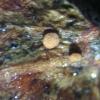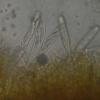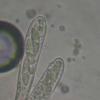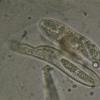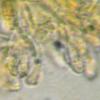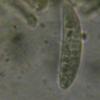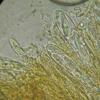
02-01-2026 17:43
MARICEL PATINOHi there, although I couldn't see the fruitbody, I

04-01-2026 17:45
 Stephen Martin Mifsud
Stephen Martin Mifsud
I was happy to find these orange asmocyetes which

03-01-2026 13:08
Niek SchrierHi all,We found groups of perithecia on a Lecanora

29-12-2025 17:44
Isabelle CharissouBonjour,J'aimerais savoir si d'autres personnes au

01-01-2026 18:35
Original loamy soil aside a artificial lake.The co

31-12-2025 19:27
Collected from loamy soil, at waterside (completel
Hello everyone,
I hope anyone of you can give me a hand with this problem
On a pine cone I found a pair of yellow / orange slices. I'm not quite sure but think that there are only fours pores in the asci. The measure of the asci is between 75-85 x18 µm. The measure of the spores is between 23-26 x 4-7 µm. I thought there were konidiensporen but were appendages of the spores. Parafysen are knobby, J-.
Is there anyone who has an idea in which direction I should think?
Greetings
Gannie
If the asci are IKI+, it might be Pezicula eucrita. It grows right now, after the rains in mid-europe.
Cheers,
Guy
Hello Guy,
Thank you, I looked for some pictures and I think you're right. Can you explain what IKI+ and how to see this?
Greetings
Hannie
IKI is the so called Lugol´s solution (or "J" - but without chloral hydrate).
With such IKI, your fungus will show a hemiamyloid (= red!) reaction of the AA (apical apparatus).
In Melzer´s reagent, the reaction is negative.
Pre-treated with KOH (5%), the reaction will be blue in Melzer´s and in Lugol´s solution and not turning into red after a little while..
Cheers,
Guy
Hello Guy,
thanks for explanation. I did it with Lugol but I can't see any reaction.
Greetings
Hannie

Hello Guy,
yes it's pale yellow. It's hard to get it here in Holland, so someone sent it to me. Maybe he put some water to it? So it's better to buy some new?
Hannie

to my experience there are several varieties of Lugol's solution in trade. I once got one that was almost clear and prepared for lichenologists, since the reaction in lichen is very strong, but gives no sufficiant results with "standard" ascomycetes. On the other hand I experienced false descriptions of the reaction where concentrations of iodine stronger than 2% were used and thus an hemiamyloid reaction was suppressed or overrun.
The standard formula for Lugol's for ascomycetes should be 1% iodine + 3% potassium iodide added to water.
Regards
Martin

I have crystalline iodine and potassium iodide and mix it needed.
See http://www.invivoveritas.de/articles/iodine-reaction/
Zotto
Martin and Zotto,
thanks for the answer. I'll study your paper Zotto but it will take some time for me.
Cheers
Hannie



